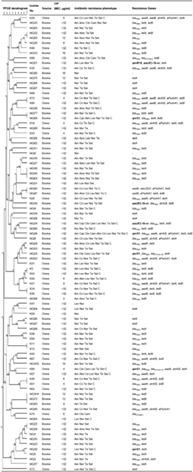当前位置:
X-MOL 学术
›
J. Food Saf.
›
论文详情
Our official English website, www.x-mol.net, welcomes your feedback! (Note: you will need to create a separate account there.)
Occurrence and characterization of ciprofloxacin‐resistant Escherichia coli from bovine and ovine bulk tank milk samples in Turkey
Journal of Food Safety ( IF 2.4 ) Pub Date : 2021-01-14 , DOI: 10.1111/jfs.12881 Cemil Kürekci 1 , Muhsin Aydın 2 , İbrahim Ozan Tekeli 3 , Pınar Ambarcıoğlu 4 , Seydi Ahmet Şengül 3 , Fatih Sakin 3
Journal of Food Safety ( IF 2.4 ) Pub Date : 2021-01-14 , DOI: 10.1111/jfs.12881 Cemil Kürekci 1 , Muhsin Aydın 2 , İbrahim Ozan Tekeli 3 , Pınar Ambarcıoğlu 4 , Seydi Ahmet Şengül 3 , Fatih Sakin 3
Affiliation

|
The objective of this study was to examine the occurrence and characteristics of ciprofloxacin‐resistant (CipR) Escherichia coli isolates on bulk tank milk (BTM) samples (bovine and ovine origins) in Turkey. A total of 91 BTM samples (41.7%, 95% confidence intervals 35.2–48.6%) out of 218 were found to be positive for CipR E. coli isolates (MIC values of ≥4 μg/ml). Analysis of PFGE fingerprint profile for E. coli isolates resulted in the 55 different pulsotypes based on >85% homology. All isolates were resistant to enrofloxacin and nalidixic acid and the resistance rates in bovine and ovine origin isolates were 94.9 and 78.1% for norfloxacin (p < .05) and 27.1 and 34.4% for levofloxacin, respectively. Additionally, resistance to non‐quinolone antibiotics was commonly observed against tetracycline (resistance rates in bovine and ovine = 91.5 and 87.5%, respectively), trimethoprim‐sulfamethoxazole (83.1 and 93.8%, respectively), gentamycin (15.3 and 40.6%, respectively, p < .05) and chloramphenicol (23.7 and 65.6%, respectively, p < .05). The qnrS1 gene (3.1 and 6.8%, respectively) was the most prevalent PMQR genes in isolates from ovine and bovine origins, followed by aac (6′)‐Ib‐cr (0 and 5.1%, respectively) and qnrB19 (0 and 1.7%, respectively). The other resistance genes including tetA, tetB, strA/B, aPozhA1, aadA, aadB, blaCTX‐M, and blaTEM were also identified in various frequencies. The most frequently observed virulence trait was fimH. The low‐level presence of PMQR genes and as well as some virulence traits is an important finding, yet the results of this study are worrisome because quinolone antibiotics are still the drugs of choice for severe infections in humans.
中文翻译:

土耳其牛和绵羊散装罐装牛奶样品中耐环丙沙星的大肠杆菌的发生和鉴定
这项研究的目的是检查土耳其散装罐装牛奶(BTM)样品(牛和羊来源)中耐环丙沙星(Cip R)大肠杆菌分离株的发生和特征。218份样本中,总共91份BTM样品(41.7%,95%置信区间35.2–48.6%)对Cip R 大肠杆菌分离株呈阳性(MIC值≥4μg / ml)。大肠杆菌分离物的PFGE指纹图谱分析基于> 85%的同源性产生了55种不同的脉冲型。所有分离株均对恩诺沙星和萘啶酸具有抗性,牛和绵羊来源分离株对诺氟沙星的耐药率分别为94.9%和78.1%(p <.05)和左氧氟沙星分别占27.1和34.4%。此外,通常观察到对非喹诺酮类抗生素具有四环素耐药性(牛和羊的耐药率分别为91.5和87.5%),甲氧苄氨嘧啶-磺胺甲基恶唑(分别为83.1和93.8%),庆大霉素(分别为15.3和40.6%)。p <.05)和氯霉素(分别为23.7和65.6%,p <.05)。所述qnrS1基因(分别为3.1和6.8%),是在从绵羊和牛起源菌株最普遍PMQR基因,随后AAC(6') -的Ib-CR(0和5.1%,分别地)和qnrB19(0和1.7 %, 分别)。其他抗性基因包括tetA,tetB,还以各种频率识别了strA / B,aPozhA1,aadA,aadB,bla CTX-M和bla TEM。最常见的毒力特征是fimH。PMQR基因的低水平存在以及某些毒力特性是一个重要发现,但这项研究的结果令人担忧,因为喹诺酮类抗生素仍然是人类严重感染的首选药物。
更新日期:2021-01-14
中文翻译:

土耳其牛和绵羊散装罐装牛奶样品中耐环丙沙星的大肠杆菌的发生和鉴定
这项研究的目的是检查土耳其散装罐装牛奶(BTM)样品(牛和羊来源)中耐环丙沙星(Cip R)大肠杆菌分离株的发生和特征。218份样本中,总共91份BTM样品(41.7%,95%置信区间35.2–48.6%)对Cip R 大肠杆菌分离株呈阳性(MIC值≥4μg / ml)。大肠杆菌分离物的PFGE指纹图谱分析基于> 85%的同源性产生了55种不同的脉冲型。所有分离株均对恩诺沙星和萘啶酸具有抗性,牛和绵羊来源分离株对诺氟沙星的耐药率分别为94.9%和78.1%(p <.05)和左氧氟沙星分别占27.1和34.4%。此外,通常观察到对非喹诺酮类抗生素具有四环素耐药性(牛和羊的耐药率分别为91.5和87.5%),甲氧苄氨嘧啶-磺胺甲基恶唑(分别为83.1和93.8%),庆大霉素(分别为15.3和40.6%)。p <.05)和氯霉素(分别为23.7和65.6%,p <.05)。所述qnrS1基因(分别为3.1和6.8%),是在从绵羊和牛起源菌株最普遍PMQR基因,随后AAC(6') -的Ib-CR(0和5.1%,分别地)和qnrB19(0和1.7 %, 分别)。其他抗性基因包括tetA,tetB,还以各种频率识别了strA / B,aPozhA1,aadA,aadB,bla CTX-M和bla TEM。最常见的毒力特征是fimH。PMQR基因的低水平存在以及某些毒力特性是一个重要发现,但这项研究的结果令人担忧,因为喹诺酮类抗生素仍然是人类严重感染的首选药物。



























 京公网安备 11010802027423号
京公网安备 11010802027423号